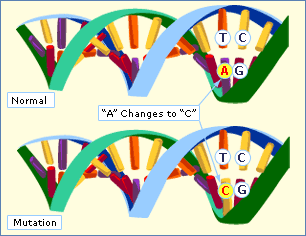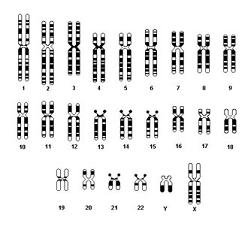Mutation that causes MCAD deficiencyA gene mutation is a permanent change in the
DNA sequence that makes up a gene.
A gene holds the instructions or "recipe" to create a protein. By changing the gene's instruction for making that protein, the protein can be malfunctioning or even completely absent. Different kinds of mutations are possible, for example:
Example
of a change in one DNA base pair:
 The mutation that causes MCAD deficiency is a mutation on the ACADM gene. The most classic mutation of this gene is called "A985G", and is of the type where one DNA base pair is changed: an adenine (A) is replaced by a guanine (G) at position 985. But tens of other mutations of this gene are known that cause MCAD deficiency. The "address" of the ACADM gene is 1p31. Geneticists use a standardized way to describe a gene's location.
Positions are defined on a chromosome using these bands. Positions are indicated by numbers. To write down the address of the gene, geneticists write the number of the chromosome, followed by a p or q, and then the position. As the address of the ACADM gene is 1p31, that means that it is located on the first chromosome, on the short arm and on position 31. That explains the image on top of this site :-) Gene mutations for the ACADM gene occur in two ways: they can be inherited from the parents or they can be newly created in the egg or sperm cell the baby originates from. In both cases the mutation is present at conception and the baby will be able to pass it on to his or her children. Read further about how this mutation is inherited >
|
||||
|
|
This page was last modified on 5 March 2011 | |||
